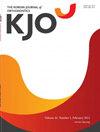Clinical expression of programmed maxillary buccal expansion and buccolingual crown inclination with Invisalign EX30 and SmartTrack aligners and the effect of 1-week vs. 2-week aligner change regimes: A retrospective cohort study.
IF 1.9
3区 医学
Q1 Dentistry
引用次数: 0
Abstract
Objective : This retrospective cohort study aimed to assess and compare the accuracy of 3 different Invisalign® treatment regimens in terms of variations of aligner change frequency and type of aligner material in achieving maxillary dental buccal expansion. Methods : Altogether, 120 adult patients whose treatment involved maxillary dental expansion with Invisalign® were included. The patients were divided into 3 groups, with each group comprising 40 patients as follows: SmartTrack® 1-week changes (ST1), SmartTrack® 2-week changes (ST2), and EX30® 2-week changes (EX2). The groups were assessed by comparing actual changes achieved with those prescribed by ClinCheck®. The rates of clinically significant inaccuracies (CSI) observed for buccal expansion (≥ 0.5 mm) and buccolingual inclination (≥ 2°) during expansion were then determined. Results : In terms of expansion, the ST1 group demonstrated the highest CSI rate at all tooth levels, whereas the ST2 group had the lowest rate of CSI and the lowest mean inaccuracy for each tooth level. In terms of buccolingual inclination, the ST1 group had the highest CSI rate across all tooth levels, whereas the EX2 group had the lowest CSI rate at all tooth levels except for the canine level where the ST2 group had the lowest CSI rate. A tendency toward overexpression of buccal crown inclination, and underexpression of buccal expansion was observed at all tooth levels. Conclusions : Two-week aligner change regimens offer improved accuracy compared with 1-week aligner changes. SmartTrack® 2-week changes were the most accurate for buccal expansion, whereas EX30® 2-week changes were the most accurate for buccolingual inclination.使用Invisalign EX30和SmartTrack矫治器进行程序化上颌颊面扩张和颊舌冠倾斜的临床表现,以及1周与2周矫治器更换周期的对比效果:一项回顾性队列研究。
目的:这项回顾性队列研究旨在评估和比较三种不同隐适美®治疗方案在实现上颌牙齿颊面扩张方面的准确性,包括矫治器更换频率和矫治器材料类型的变化:方法:共纳入了120名使用隐适美®进行上颌牙颊面扩大治疗的成年患者。这些患者被分为 3 组,每组 40 人,具体如下:SmartTrack® 1 周变化组(ST1)、SmartTrack® 2 周变化组(ST2)和 EX30® 2 周变化组(EX2)。通过比较实际变化与 ClinCheck® 规定的变化,对各组进行了评估。然后确定在扩弓过程中观察到的颊侧扩弓(≥ 0.5 毫米)和颊舌侧倾斜(≥ 2°)的临床重大误差率(CSI):在扩弓方面,ST1 组在所有牙齿水平上的 CSI 率最高,而 ST2 组的 CSI 率最低,在每个牙齿水平上的平均误差也最小。在颊舌侧倾斜方面,ST1 组在所有牙齿水平上的 CSI 率最高,而 EX2 组在所有牙齿水平上的 CSI 率最低,但在犬齿水平上,ST2 组的 CSI 率最低。在所有牙齿水平上都观察到了颊侧牙冠倾斜过度和颊侧扩张不足的趋势:结论:与一周一换的矫治器相比,两周一换的矫治器更准确。SmartTrack®两周换一次矫治器对颊面扩大的测量最为准确,而EX30®两周换一次矫治器对颊舌向倾斜的测量最为准确。
本文章由计算机程序翻译,如有差异,请以英文原文为准。
求助全文
约1分钟内获得全文
求助全文
来源期刊

Korean Journal of Orthodontics
Dentistry-Orthodontics
CiteScore
2.60
自引率
10.50%
发文量
48
审稿时长
3 months
期刊介绍:
The Korean Journal of Orthodontics (KJO) is an international, open access, peer reviewed journal published in January, March, May, July, September, and November each year. It was first launched in 1970 and, as the official scientific publication of Korean Association of Orthodontists, KJO aims to publish high quality clinical and scientific original research papers in all areas related to orthodontics and dentofacial orthopedics. Specifically, its interest focuses on evidence-based investigations of contemporary diagnostic procedures and treatment techniques, expanding to significant clinical reports of diverse treatment approaches.
The scope of KJO covers all areas of orthodontics and dentofacial orthopedics including successful diagnostic procedures and treatment planning, growth and development of the face and its clinical implications, appliance designs, biomechanics, TMJ disorders and adult treatment. Specifically, its latest interest focuses on skeletal anchorage devices, orthodontic appliance and biomaterials, 3 dimensional imaging techniques utilized for dentofacial diagnosis and treatment planning, and orthognathic surgery to correct skeletal disharmony in association of orthodontic treatment.
 求助内容:
求助内容: 应助结果提醒方式:
应助结果提醒方式:


